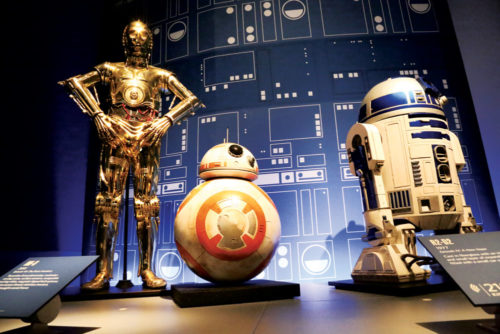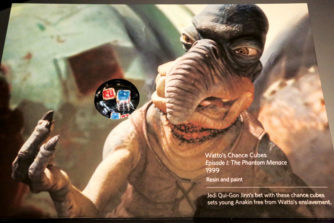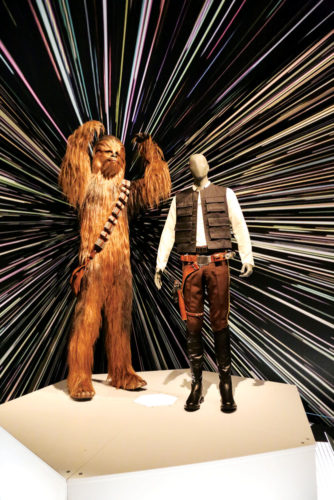
The exhibit explores the connections between costume and character with recognizable costumes in 13 thematic sections—including Jedi vs. Sith and the Galactic Senate. Focusing on the creative process of bringing characters to life, the exhibit features many original designs, as well as an art studio, costume shop and fitting room. In the foreground is the gown Queen Apailana wore at the funeral of Padme Amidala.
The discovery is in the details. Star Wars and the Power of Costume at Denver Art Museum, on exhibit through April 2, shows off the finer points of the costumes—the real costumes—worn by Star Wars’ iconic characters. From the evil Emperor’s brown and broken fingernails, to the origins of Princess Leia’s famous hairdo, the exhibition gives visitors a close look at the creative process of giving the characters visual credibility.

Robots (left to right): C-3PO is made of 30 pounds of fiberglass; BB-8 is equipped with an accelerometer, surface sensors, and swappable tool bay disks; R2-D2 is made of fiberglass and expanding foam with a small car seat inside.
“I have to know a character in order to design him,” said concept artist Iain McCaig, whose drawings guided the costumes in episodes 1, 2, 3 and 7. “Who’s in there? The spirit that a character manifests.”

Watto, a junk dealer/human trafficker, throws the dice for young Anikan’s freedom. Three-dimensional dice are among the hidden movie ephemera intended for Star Wars ‘super-fans’ and kids.
Star Wars emphasizes the process of costuming, from concept to design. The exhibition represents nearly 40 years of Star Wars, a seven-film, multigenerational telling of the hero’s journey myth. Stephania Van Dyke, DAM interpretive specialist, visited the archives of the Lucas Museum of Narrative Art at Skywalker Ranch to gather materials for the customized show. “We got to dig deep for original molds, paper patterns and original designer notes,” Van Dyke said. “One of the special items we found was the concept for the planet Naboo, based on the painting “Dream of Arcadia” by Thomas Cole, which resides on the sixth floor of the DAM. So there’s a real connection between Star Wars and the DAM.”
“The costumes are really well-made, unlike in some films,” said Laela French, director of archives for the Lucas Museum of Narrative Art. “Costume details enrich the character, even if she is onscreen for mere seconds. Queen Amidala’s black velvet gown features a handmade lace front that took more than a month to weave.”
Inspirations for costumes came from places like Mongolia, Tibet and Japan. Princess Leia’s double-bun hair design was inspired by Hopi women.
In addition to the costumes, “easter eggs” are hidden throughout the galleries for super-fans and kids. Among the small ephemera are Leia’s 1979 digital watch/communicator, a plastic and metal version of a device that hadn’t been invented yet; and a three-dimensional view, at child-height, of a winged Ewok. A close look at a rebel pilot’s vest reveals costume shop inside jokes, including a scribbled note: “When do we get out of here?”

Chewbacca, a Wookiee warrior (a combination of a monkey, a dog and a cat) was a loyal partner to Han Solo, and a reluctant hero of the Rebel Alliance.
Mc Caig said characters often change during the creative process—but not always for the better. He was disappointed in Jar Binks, a silly-voiced creature that became a sore spot with some fans. “I long to go back to our original idea for Jar Binks,” Mc Caig said. “He was silent, like Charlie Chaplin; he had all this energy and no way to get it out. He was funny. But at the last minute the idea fell off and he was given a voice.”
Making Mc Caig’s drawings real was the job of the costume shop, which employed as many as 60 makers. “We made more than 1,000 costumes,” said Star Wars creator George Lucas in a short film that is part of the exhibition. “It’s one thing to draw something on a piece of paper, and it’s another thing to actually make it three-dimensional and make it work. We’re always conscious of how costumes move on the actor. We want them to look better than on paper, and that requires understanding fabrics and how they look under different lighting conditions.”
Many costumes show the results of altered fabrics. “Costume designer Trisha Biggar did everything possible to the fabric to make it look a certain way,” said French. “She heated rubber fabric and embedded stones in it. She did smocking on a velvet robe for a gathered effect, which took six months to do. She dyed velvet fabric, graded from yellow to orange.”
For more information, visit denverartmuseum.org.



0 Comments